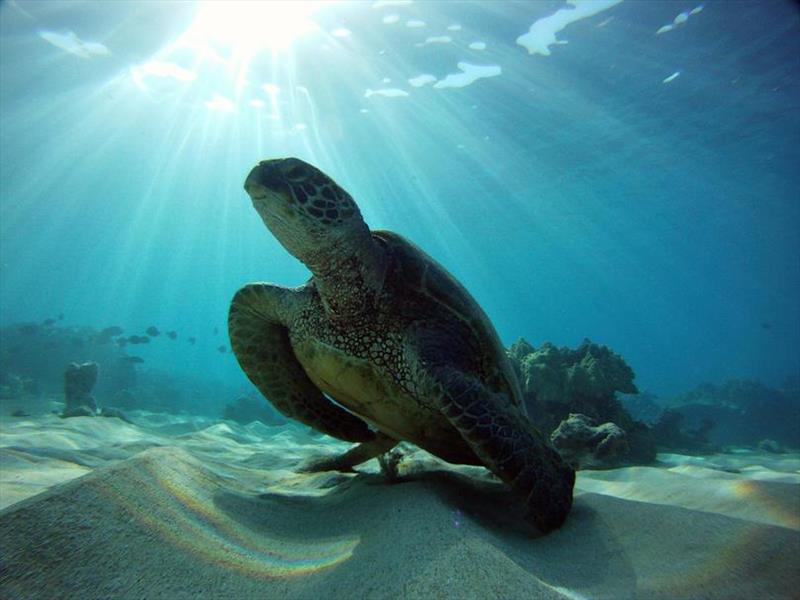
Sea Turtle Week 2021 - Seven sea turtle facts for the ocean lover
by NOAA Fisheries 19 Jun 2021 15:39 UTC

Green sea turtle underwater © NOAA / Ed Lyman
Celebrate Sea Turtle Week with NOAA Fisheries! Sea turtles have been swimming in Earth's oceans for hundreds of millions of years. These marine reptiles lead incredible lives, surviving for many decades at sea. They travel thousands of miles in search of food, eventually returning to the beaches where they were born to nest.
They are a key part of marine ecosystems worldwide, but they face many threats today. Six sea turtle species are found in U.S. waters and all are threatened or endangered. The largest among them—the Pacific leatherback—is critically endangered. Of all the species NOAA Fisheries protects under the Endangered Species Act, we consider the Pacific leatherback to be one of the nine species most at risk of extinction in the near future.
Explore turtle features and videos below. Stay tuned all week to learn how we conserve and protect sea turtles and how you can help too.
Sea turtle features
Meet Dr. Brian Stacy, Sea Turtle Veterinarian and Scientist
Dr. Brian Stacy works to recover threatened and endangered sea turtles in the NOAA Fisheries Office of Protected Resources.
Learn more about Dr. Brian Stacy and his work
Sea Turtle Week 2021: Celebrating Sea Turtle Conservation
Welcome to Sea Turtle Week 2021! This annual campaign celebrates these highly migratory marine reptiles by focusing attention on the threats they face and the conservation efforts to protect them.
Sea turtle conservation and how you can help
7 sea turtle facts for the ocean lover
Sea turtles are fascinating creatures. Learn some facts about these much loved marine reptiles.
See more sea turtle facts
Meet NOAA Fisheries' southeast sea turtle biologists
NOAA biologists answer questions about how they got into sea turtle research and what they do to better understand and conserve the species.
Meet Southeast scientists Dr. Chris Sasso, Dennis Klemm and Dr. Melissa Cook
Tag, You're It! Tracking sea turtle movements with satellite tags
Biologists had the opportunity to capture and place satellite tags on leatherback sea turtles in North Carolina, Massachusetts, and the northeastern Gulf of Mexico. This gives us new data about the coastal habitat used by this species. It also gave us a better understanding of relationship between turtle movements and behavior and human activities.
Learn more about leatherback sea turtle research
The "Circles" of Life: Learning about hawksbill sea turtles from their bones
Our scientists analyze marks in the bones of sea turtles that wash ashore dead (strand) that are similar to tree rings. Collaborating with the National Sea Turtle Stranding and Salvage Network, we have collected bones from stranded turtles over large areas and long periods of time. We cut cross-sections of bone and conduct a type of laboratory tissue processing called histology to highlight the marks.
See what we're learning from analyzing sea turtle bones
Get my drift? using drift studies to understand sea turtle stranding patterns
Every year, dead sea turtles wash up, or "strand," on U.S. beaches. NOAA Fisheries' scientists want to understand how weather patterns and ocean currents influence annual sea turtle strandings.
Learn more about drift studies
Traveling turtles: rescue and rehabilitation of cold stunned sea turtles story map
Cold stunning is a natural phenomenon on Cape Cod, Massachusetts. However, the number of turtles that strand (wash up on beaches) each year has been steadily increasing in recent decades.
Explore this story map to learn more about cold stunned sea turtles and the partners who help save them
What can you do to save sea turtles?
Sea turtles face a number of threats including pollution, marine debris, degradation of habitat, vessel strikes, and bycatch. There are many ways that you can help us protect sea turtles.
Learn what actions you can take to help save sea turtles
Sea turtle videos
Celebrating Sea Turtles
Go slow: sea turtles below
Leatherback sea turtles: understanding the Pacific population
Sea turtles: is the future female?
Hawaiian hawksbill turtles: one of the world's most endangered sea turtle populations